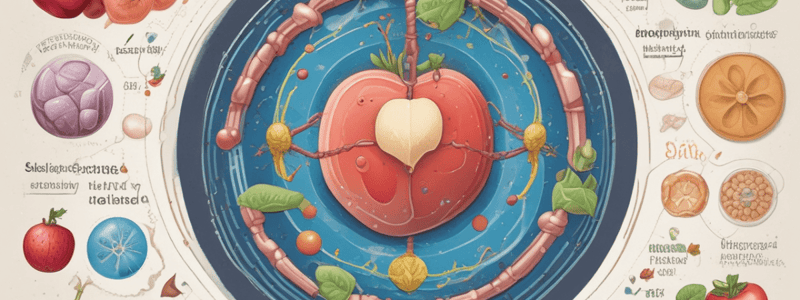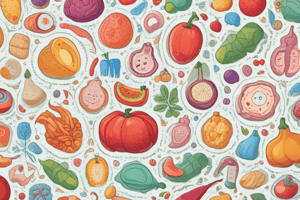Podcast
Questions and Answers
What are the two primary processes involved in lipid metabolism?
What are the two primary processes involved in lipid metabolism?
The two primary processes involved in lipid metabolism are lipogenesis (synthesis of fats) and lipolysis (breakdown of fats).
What is the role of lipids in the construction of cell membranes?
What is the role of lipids in the construction of cell membranes?
Lipids, particularly phospholipids, are essential components of cell membranes. They form the structural basis of the membrane, creating a barrier that controls the passage of molecules in and out of the cell.
Where in the body are lipids primarily synthesized in animals?
Where in the body are lipids primarily synthesized in animals?
In animals, the liver is the primary site for lipid synthesis.
What is the primary source of lipids for animals?
What is the primary source of lipids for animals?
What is the purpose of breaking down lipids in the body?
What is the purpose of breaking down lipids in the body?
Describe the process of lipogenesis.
Describe the process of lipogenesis.
Why is lipid metabolism important for overall health?
Why is lipid metabolism important for overall health?
What are some examples of functional lipids besides those involved in cell membranes?
What are some examples of functional lipids besides those involved in cell membranes?
What are the primary types of lipids found in the human body from food ingestion?
What are the primary types of lipids found in the human body from food ingestion?
What are the two major sources of fats that vertebrates use to obtain energy?
What are the two major sources of fats that vertebrates use to obtain energy?
Why do lipids need to be solubilized before metabolism begins?
Why do lipids need to be solubilized before metabolism begins?
What is the first step in lipid metabolism?
What is the first step in lipid metabolism?
In which cells are fatty acids absorbed during lipid metabolism?
In which cells are fatty acids absorbed during lipid metabolism?
List two metabolic processes involved in lipid metabolism.
List two metabolic processes involved in lipid metabolism.
What role does lipid transportation play in the body?
What role does lipid transportation play in the body?
How does lipid metabolism in plants differ from that in animals?
How does lipid metabolism in plants differ from that in animals?
What organelles are primarily involved in lipid catabolism?
What organelles are primarily involved in lipid catabolism?
Which enzyme initiates lipid digestion in the mouth?
Which enzyme initiates lipid digestion in the mouth?
Where in the digestive system does the majority of lipid digestion and absorption occur?
Where in the digestive system does the majority of lipid digestion and absorption occur?
What is the role of pancreatic lipase in lipid metabolism?
What is the role of pancreatic lipase in lipid metabolism?
What happens to ingested cholesterol during lipid digestion?
What happens to ingested cholesterol during lipid digestion?
Which types of lipases continue the digestion of fats in the stomach?
Which types of lipases continue the digestion of fats in the stomach?
What substances from the pancreas assist in lipid breakdown in the small intestine?
What substances from the pancreas assist in lipid breakdown in the small intestine?
What is the outcome of triglyceride digestion in the small intestine?
What is the outcome of triglyceride digestion in the small intestine?
Where does the majority of fat absorption take place?
Where does the majority of fat absorption take place?
What structures do fatty acids and glycerol aggregate into to facilitate absorption?
What structures do fatty acids and glycerol aggregate into to facilitate absorption?
What is the role of the cytosol in lipid absorption?
What is the role of the cytosol in lipid absorption?
What type of particles are formed in the cytosol to transport digested lipids?
What type of particles are formed in the cytosol to transport digested lipids?
Why do triglycerides and cholesterol require special transport proteins?
Why do triglycerides and cholesterol require special transport proteins?
What type of structures are lipoproteins, and what do they allow?
What type of structures are lipoproteins, and what do they allow?
What is the role of chylomicrons in lipid transportation?
What is the role of chylomicrons in lipid transportation?
What type of tissues do chylomicrons eventually enter?
What type of tissues do chylomicrons eventually enter?
Explain the role of lipoprotein lipase in lipid catabolism and where it is located.
Explain the role of lipoprotein lipase in lipid catabolism and where it is located.
What happens to glycerol after it is released from triglycerides during lipid catabolism? Where does this process occur?
What happens to glycerol after it is released from triglycerides during lipid catabolism? Where does this process occur?
Why is the conversion of long-chain fatty acids into fatty acyl-CoA necessary for lipid catabolism? Where does this conversion take place?
Why is the conversion of long-chain fatty acids into fatty acyl-CoA necessary for lipid catabolism? Where does this conversion take place?
Describe the role of acyl-CoA synthetase in lipid catabolism.
Describe the role of acyl-CoA synthetase in lipid catabolism.
What is beta-oxidation and where does it occur? Explain its importance in the breakdown of fatty acids.
What is beta-oxidation and where does it occur? Explain its importance in the breakdown of fatty acids.
How does the energy from the breakdown of triglycerides contribute to the overall energy production of the cell?
How does the energy from the breakdown of triglycerides contribute to the overall energy production of the cell?
Why is the breakdown of lipids a significant source of energy for the body? Provide at least two reasons.
Why is the breakdown of lipids a significant source of energy for the body? Provide at least two reasons.
Explain how the process of lipid catabolism is linked to the production of ATP, the main energy currency of the cell.
Explain how the process of lipid catabolism is linked to the production of ATP, the main energy currency of the cell.
Flashcards are hidden until you start studying
Study Notes
Lipid Metabolism Overview
- Involves synthesis and degradation of lipids in cells.
- Key processes include breakdown and storage of fats for energy.
- Synthesizes structural and functional lipids, essential for cell membranes.
Sources of Lipids
- Fats are acquired from dietary sources and synthesized by the liver.
- Major lipids include triglycerides and cholesterol, alongside fatty acids and membrane lipids.
Metabolic Processes
- Lipid metabolism includes:
- Lipid digestion
- Lipid absorption
- Lipid transportation
- Lipid storage
- Lipid catabolism
- Lipid biosynthesis
Lipid Digestion
- Begins with breaking down triglycerides into monoglyceride units via lipase enzymes.
- Initial digestion occurs in the mouth through lingual lipase.
- Gastric lipase in the stomach continues digestion.
- Significant lipid digestion occurs in the small intestine with the help of pancreatic enzymes and bile salts.
Lipid Absorption
- Short-chain fatty acids can be absorbed in the stomach, while most absorption occurs in the small intestine.
- Digested lipids aggregate into micelles, allowing for diffusion across intestinal epithelial cells.
- Fatty acids and monoglycerides are recombined into triglycerides in the cytosol of epithelial cells.
- Packaged into chylomicrons, which are transported to other tissues via the bloodstream.
Lipid Transportation
- Lipoproteins facilitate the transportation of hydrophobic lipids through the blood.
- Chylomicrons are a type of lipoprotein carrying digested lipids from the small intestine to the body.
Lipid Catabolism
- Begins once lipoproteins travel to tissues, where lipoprotein lipase breaks down triglycerides.
- Fatty acids and glycerol enter cells; remaining cholesterol returns to the liver.
- Glycerol is converted to glyceraldehyde 3-phosphate in cells, contributing to energy production.
- Fatty acids undergo catabolism primarily in mitochondria through beta oxidation.
Fatty Acid Activation
- Long-chain fatty acids (>14 carbon atoms) are converted to fatty acyl-CoA before they pass across mitochondrial membranes.
- Acyl-CoA synthetase catalyzes the addition of coenzyme A to fatty acids using ATP energy.
Beta Oxidation
- Occurs in mitochondria, breaking down acyl-CoA to produce energy from fatty acids.
Studying That Suits You
Use AI to generate personalized quizzes and flashcards to suit your learning preferences.




